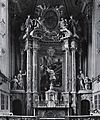High altar of the Andreas Church (Düsseldorf)
The high altar of the Andreas Church in Düsseldorf is considered the most important work of art of the Düsseldorf Baroque . This was created under the influence of Italian-South German construction based on designs by Antonio Serro.
description
Paul Clemen describes the lost high altar in Die Kunstdenkmäler der Rheinprovinz .
The lower part of the high altar was structured in many ways. There was also the altar mess with the tabernacle crowned by a pelican. To the side, on the side walls of the baroque altar, were the figures of Saints Ignatius, Aloysius, Francis, Xaverius and Aloysius Gonzaga .
The middle field was completed by a drapery of purple velvet. Behind this was a life-size, painted crucifix that came from the 16th century. In the middle on a high tower stood a small wooden figure of the Madonna with the child on earth and crescent between two angels, at the top was the richly gilded electoral coat of arms. The middle field was flanked by six columns with gilded Corinthian capitals that rested on the lower part of the high altar.
In the upper part there was a high, polygonal architrave, supported on the six columns. On top of it rose a curved and blown ornamental gable, which was adorned with a painting with the theme of the Assumption of Mary , which has been preserved and now hangs in the former royal boxes of the church. The painting was oval-shaped, framed with a halo, on which sat two angels wearing a crown. This was flanked by kneeling angels pointing to the painting, behind them were the figures of Saints Ignatius and Aloysius, and two urns at the end.
“[The] high altar is a mighty, richly decorated structure, which is connected to the side walls by arches with doors, over which the figures of the hh. Ignatius, Aloysius, Franziskus, Xaverius, Aloysius Gonzaga, the two outer kneeling, are set up. The high polygonal architrave, which again bears the curved, broken gable, rises above a well-structured base on six columns with gilded Corinthian capitals. The coronation is a painting of the rising Madonna in an oval frame with radiant sun, on which two angels sit holding a crown. Angels kneel to one side, pointing out the process in the middle, behind them S. Ignatius and S. Aloysius, two urns at the end. The central field, which opens above the tabernacle crowned with a pelican, is closed by a drapery of purple velvet, behind which an older, life-size painted crucifix from the 16th century is visible. In the middle on a high attachment a small wooden figure of the Madonna with the child on earth and crescent between two angels, at the top the richly gilded electoral coat of arms "
Art historical significance
Paul Sültenfuß describes the influence of Italian-South German construction. Antonio Serro, known as Kraus, master of the court church in Neuburg ad Donau, had provided the new Duke of Jülich-Berg , Wolfgang Wilhelm from the Palatinate-Neuburg family , with designs.


